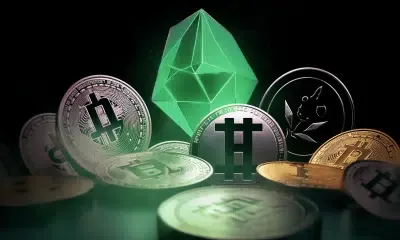How to Mine or Stake Solana to Earn Rewards in 2024 (Guide)
Maximize your Solana earnings through rewards! Dive into our 2024 guide for mining or staking SOL, uncovering the strategies to earn lucrative rewards in the crypto realm today.

In 2024, the opportunities to earn rewards through Solana (SOL) have never been more enticing, blending the allure of cutting-edge technology with the promise of tangible gains. However, many people wonder: Can you stake Solana in 2024?
Join us as we unlock the secrets of mining and staking Solana and discover how you can turn your crypto endeavors into rewarding ventures in 2024.
Can you mine Solana?

Unveiling if users can mine Solana – Image via Solana
Mining Solana is not possible due to its underlying consensus mechanism. Solana uses a Proof of Stake (PoS) model as opposed to a Proof of Work (PoW) system used by cryptocurrencies like Bitcoin (BTC), where miners solve unique and complicated mathematical puzzles to validate transactions and create new blocks. In this system, there are no miners but validators and delegators.
Validators are in charge of generating new blocks and verifying transactions under the PoS consensus model. The quantity of cryptocurrency that they are willing to “stake,” or lock up as security, determines which ones are selected. Validators do not “mine” in the conventional sense because they are not required to solve cryptographic puzzles in order to receive rewards in the form of transaction fees and, occasionally, more cryptocurrency.
Delegators, on the other hand, are individuals who may not have the resources or desire to become validators themselves but still wish to participate in the network’s consensus process. They can delegate their coins to a validator and earn a share of the rewards the validator receives for participating in the consensus process.
Before diving into mining or staking, understanding the core principles of Solana’s network, including its decentralization, is crucial for any investor.
How to stake Solana to earn rewards
Although Solana cannot be mined, you can easily stake SOL. To engage in staking Solana, a process that not only allows participants to earn passive income but also contributes to the network’s overall health and security, follows these detailed steps:
Step 1: Creating a stake account
The first step towards staking Solana is to create a stake account. This is a special type of account on the Solana blockchain designed to hold your staked SOL tokens. Here’s how to proceed:
- Transfer the amount of SOL you wish to stake into your wallet. Consider keeping a small amount of SOL available for transaction fees.
- Navigate to the staking section of your wallet. This option is typically found in the wallet’s main menu or under a “Staking” or “Earn” tab.
- Initiate the creation of a new stake account. You’ll be taken through several prompts to allocate the desired amount of SOL to this account. The process includes specifying the amount to stake and setting up additional staking preferences.
Step 2: Picking a validator
Choosing the right validator is crucial for maximizing your staking rewards and ensuring the security of your staked Solana. Consider the following when selecting a validator:
- Uptime and performance: A validator’s uptime is critical. Look for those with a high and consistent uptime score, indicating reliability.
- Community reviews and reputation: Explore community forums, social media, and staking platforms to gauge the community’s sentiment and experiences with different validators.
- Node distribution: Assess validators based on the geographic distribution of their nodes. Diversified node locations can enhance the network’s resilience.
Platforms like Solana Beach and services such as Stakewiz offer comprehensive insights and data on validators, helping you make an informed decision.
Considering mining or staking as a way to accumulate Solana? First, explore if Solana is a sound investment for you in 2024.

How to mine or stake SOL tokens
Step 3: Delegating SOL tokens
After selecting a validator, the next step is to delegate your Solana tokens to them, effectively starting the staking process. Within your wallet’s staking interface, select the option to delegate your stake.
Moreover, choose the validator you’ve decided on from the list provided. You might need to enter the validator’s unique address if it’s not readily available in your wallet’s interface. Finally, confirm the delegation and complete any required steps to finalize the process. This might involve signing a transaction and paying a small fee in SOL.
Step 4: Earning and monitoring your staking rewards
Your SOL tokens will start earning rewards automatically. The rewards are typically distributed at regular intervals, often every few days, and automatically compounded back into your stake.
Regularly check your staking rewards. Most wallets provide a dashboard or summary of your staking activities, including accrued rewards and the current annual percentage yield (APY).
Furthermore, stay informed about your validator’s performance and the overall health of the Solana network. Be prepared to re-delegate your stake to another validator if your current choice underperforms or if there are significant changes in the network that affect staking rewards.
Also, engage with the Solana community through forums, social media, and other platforms to stay updated on staking strategies and insights.
As staking rewards you get SOL tokens, generally at the rate of 5.01%, and as per our estimates, you would need to accumulate around 2000 SOL tokens to become a millionaire in the next ten years.
Choosing the right platform to stake Solana
As it cannot be mined, choosing the right platform for staking Solana is a pivotal decision. Moreover, this decision hinges on your preferences for security, control, and ease of use.
Solana can be staked through crypto exchanges or via wallets. Take a look at some of the prominent examples of exchanges and wallets used to stake Solana:
1. Cryptocurrency exchanges
- Binance: Known for its extensive cryptocurrency support, Binance offers a straightforward staking process, appealing to users who prioritize convenience and a wide range of staking options. It’s an ideal choice for those looking for a blend of user-friendliness and robust security protocols.
- Gemini: Emphasizing security and regulatory compliance, Gemini provides a secure environment for staking with the added benefit of regulatory oversight, making it a good option for cautious investors.
- Coinbase: As one of the largest and most reputable exchanges globally, Coinbase offers a simplified staking experience with the convenience of using a familiar platform coupled with strong customer support.
- Kraken: Kraken stands out for its security features and a diverse range of staking options, including SOL. It’s tailored for users who seek both the security of a centralized exchange (CEX) and the flexibility to explore various staking opportunities.
The classification of Solana as a security has implications for investors, which is an essential consideration alongside mining or staking activities. Find out more!

Exploring the platforms to stake SOL tokens
2. Non-custodial wallets
- Phantom wallet: Widely regarded as the go-to wallet for Solana users, Phantom offers a seamless user interface, robust security features, and direct integrations with various Solana-based applications, making it a versatile choice for both beginners and experienced users alike.
- Solflare wallet: Solflare is another excellent choice, offering a dedicated staking interface that simplifies the process of delegating your SOL tokens. It’s available as a web extension and a mobile app, providing flexibility across devices.
- Sollet.io: For those seeking a more bare-bones, web-based wallet, Sollet.io provides a straightforward interface for managing SOL and other Solana-based tokens. Moreover, it’s more technical than Phantom or Solflare, catering to users who prefer a minimalist approach.
Factors that determine profits on staking Solana
The potential profit you can earn from staking Solana and earning rewards can vary significantly and depend on several factors:
- Current staking rate: The current estimated APY for staking SOL fluctuates and is currently around 5.01%, according to Coinbase. Moreover, this is not guaranteed and can change over time.
- Amount staked: The more SOL tokens you stake, the higher the potential rewards you’ll earn. However, keep in mind that staking a larger amount also increases your potential risk.
- Validator commission: Validators charge a commission fee from the staking rewards they generate. Also, this fee typically ranges from 0% to 10%, and choosing a validator with a lower commission will increase your overall profit.
- Network inflation: Solana has a built-in inflation rate to incentivize staking. While inflation can increase the total amount of SOL in circulation, it can also dilute the value of individual tokens over time.
Therefore, it’s difficult to predict the exact profit you can make from staking SOL. However, using a staking calculator available on various cryptocurrency platforms can help you estimate your potential rewards based on the current APY, the amount you stake, and the chosen validator’s commission rate.
If you’re looking to calculate your profits through staking Solana, calculate your total earnings with our Solana profit calculator!
Things to consider before you stake Solana
If you are bummed to know that Solana cannot be mined, don’t fret. You can still earn rewards through staking Solana. However, here are a few important things to remember while staking Solana for rewards:
- Choose your staking method wisely: Consider the trade-off between convenience and control. Exchanges offer a more straightforward process but might have lower returns. Furthermore, mon-custodial wallets provide more control and potentially higher rewards but require more technical knowledge and self-responsibility.
- Be aware of lockup periods and fees: Some staking options might have lockup periods where you cannot withdraw your SOL for a certain time. Additionally, be mindful of any staking fees or network transaction fees associated with staking and unstaking.
- Do your own research and manage risk: Always conduct your own research and never share your private keys with anyone. Also, remember that cryptocurrency markets are volatile, and staking involves inherent risks.
After earning rewards through mining or staking, learn how to add Solana to MetaMask in 5 easy steps, enabling you to manage your assets effectively.

Decoding the future trajectory of SOL staking
Conclusion
As we wrap up our journey through the intricacies of mining and staking Solana, it’s clear that the opportunities within this blockchain are ripe for the taking in 2024. The landscape of Solana offers a fertile ground for those willing to navigate its challenges. Moreover, it has the promise of financial rewards and a sense of pioneering in the digital frontier.
By embracing the strategic insights provided, you’re stepping into a world where your crypto endeavors can flourish. Finally, this marks your participation in the future of finance with the innovative spirit of Solana.




